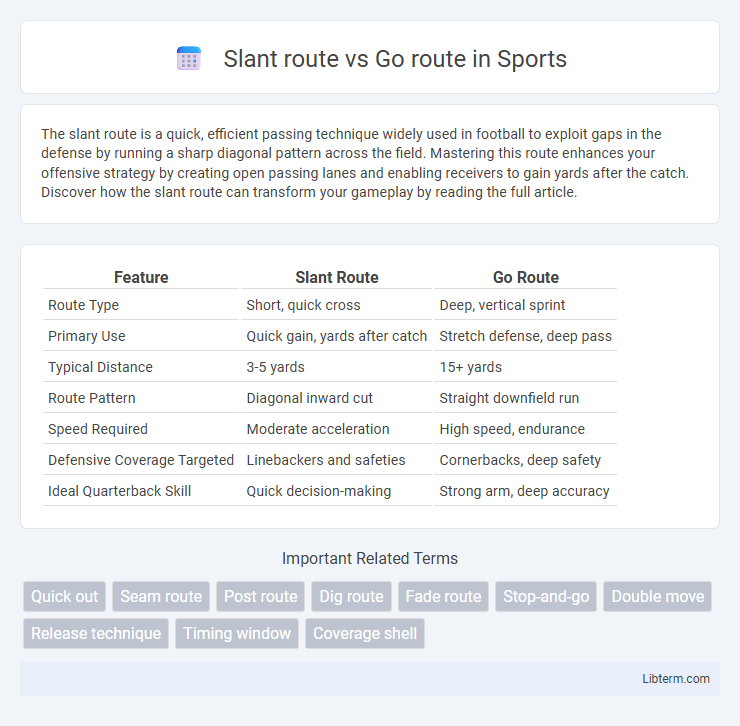The slant route is a quick, efficient passing technique widely used in football to exploit gaps in the defense by running a sharp diagonal pattern across the field. Mastering this route enhances your offensive strategy by creating open passing lanes and enabling receivers to gain yards after the catch. Discover how the slant route can transform your gameplay by reading the full article.
Table of Comparison
| Feature | Slant Route | Go Route |
|---|---|---|
| Route Type | Short, quick cross | Deep, vertical sprint |
| Primary Use | Quick gain, yards after catch | Stretch defense, deep pass |
| Typical Distance | 3-5 yards | 15+ yards |
| Route Pattern | Diagonal inward cut | Straight downfield run |
| Speed Required | Moderate acceleration | High speed, endurance |
| Defensive Coverage Targeted | Linebackers and safeties | Cornerbacks, deep safety |
| Ideal Quarterback Skill | Quick decision-making | Strong arm, deep accuracy |
Introduction to Football Routes
Slant and Go routes are fundamental passing concepts in football that shape offensive gameplay strategies. The Slant route involves a quick, sharp 3-5 yard diagonal cut across the field designed to exploit gaps in the defense for rapid completions. The Go route, also known as a fly route, requires the receiver to sprint straight downfield, aiming to outrun defenders and create deep passing opportunities for significant yardage gains.
What is a Slant Route?
A slant route is a quick, short intermediate passing pattern where the receiver runs a diagonal path across the field at a 45-degree angle. It is designed to create separation from defenders quickly and exploit gaps in zone coverage. Compared to a go route, which is a deep vertical route intended to stretch the defense, the slant route emphasizes speed, timing, and precise route running for short to intermediate gains.
What is a Go Route?
A Go route, also known as a fly route, is a deep passing route where the receiver runs straight downfield aiming to outrun defenders and catch a long pass. It prioritizes speed and timing, creating opportunities for explosive yardage or touchdowns by stretching the defense vertically. Go routes are fundamental in vertical passing attacks, forcing defenses to cover deep zones aggressively.
Key Differences: Slant vs Go Route
The key difference between the slant route and the go route lies in their depth and speed; the slant route is a short, quick-hitting pattern where the receiver cuts sharply across the field at a shallow angle, typically 3-5 yards downfield. In contrast, the go route, also known as a fly route, involves the receiver sprinting straight downfield, aiming to outrun defenders for a deep pass often 15+ yards or more. The slant excels at exploiting quick yardage and creating separation in tight coverage, while the go route is designed for big plays and stretching the defense vertically.
Situational Usage: When to Call Each Route
Slant routes are ideal for short to intermediate gains in quick-decision scenarios, especially against zone defenses or when the receiver needs to beat press coverage quickly. Go routes suit situations demanding deep yardage, typically called during clear passing downs or when exploiting single coverage to stretch the defense vertically. Quarterbacks often choose slant routes on third-and-short or against aggressive secondaries while reserving go routes for third-and-long or two-minute drill situations to maximize explosive play potential.
Advantages of Slant Routes
Slant routes offer advantages such as quicker receiver separation due to their short, diagonal path across the field, enabling faster timing and easier completion against zone defenses. The route's natural leverage on defenders creates favorable matchups, allowing quarterbacks to exploit openings efficiently. Compared to go routes, slant routes reduce the risk of turnovers by keeping the ball safer over shorter distances and enhancing yards-after-catch opportunities.
Advantages of Go Routes
Go routes provide wide receivers with a straight, vertical path downfield, maximizing yardage potential and stretching the defense deep. This route effectively creates explosive plays by exploiting blitzes and coverage mismatches, often leading to big gains or touchdowns. By forcing defenders to cover more ground, Go routes open up opportunities for other passing plays and running lanes.
Defensive Strategies Against Each Route
Defensive strategies against a slant route emphasize quick, inside leverage with linebackers or slot cornerbacks breaking on the ball to disrupt timing and prevent yards after catch, often using man-to-man coverage with press techniques or a nickel defense. In contrast, defending a go route requires defensive backs to maintain deep coverage with proper trail technique, relying on safety help over the top to prevent long completions and using zone coverage schemes like Cover 3 or Cover 4 to minimize deep threats. Effective pass rush timing is crucial against both routes to limit the quarterback's time to capitalize on the quick slant or the vertical go route.
Player Skill Sets for Slant and Go Routes
Slant routes require wide receivers to have quick acceleration, sharp route-running skills, and precise footwork to create separation in tight windows. Go routes depend heavily on speed and top-end burst, as receivers must outrun defenders in deep coverage and maintain stamina for sustained sprints. Both routes emphasize hand-eye coordination for catching under pressure, but slant routes prioritize agility while go routes prioritize straight-line speed.
Impact on Offensive Game Strategy
The Slant route enhances quick timing and short-yardage gains, creating opportunities for fast completions and exploiting gaps in zone coverage, which forces defenses to react quickly and can open up the middle field. The Go route, emphasizing speed and vertical threat, stretches the defense deep, creating space underneath for other routes and significantly impacting downfield play-calling by forcing safeties to stay back. Combining Slant and Go routes diversifies offensive strategies, blending quick anticipation with explosive vertical plays to keep defenses off balance and maximize yardage potential.
Slant route Infographic

 libterm.com
libterm.com